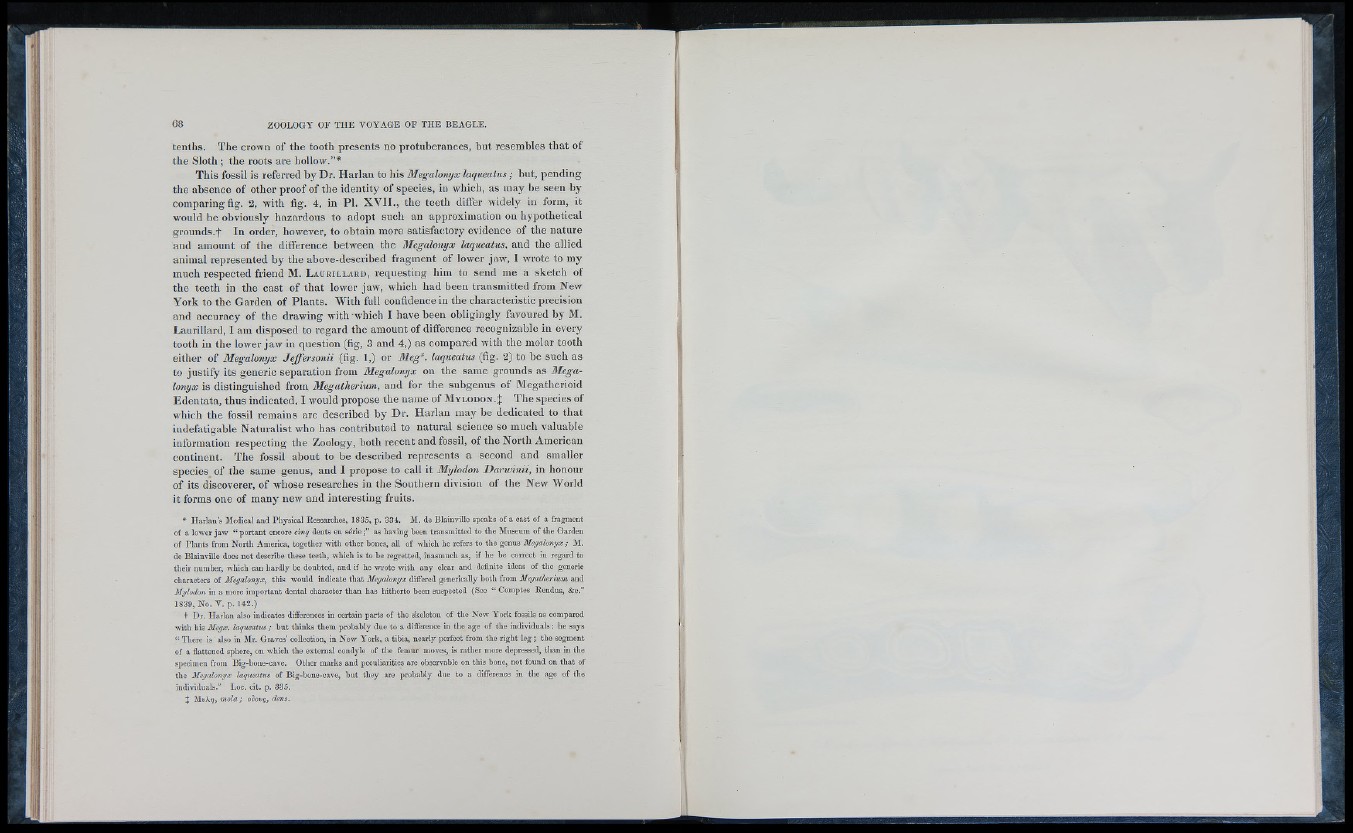
tenths. The crown o f the tooth presents no protuberances, but resembles that of
the Sloth ; the roots are hollow.”*
This fossil is referred by D r. Harlan to his Megalonyx laqueatus ; but, pending
the absence o f other proof o f the identity o f spe cie s, in which, as may be seen by
comparing fig. 2, with fig. 4, in PI. X V I I ., the teeth differ widely in form, it
would be obviously hazardous to adopt such an approximation on hypothetical
g rounds.t In order, however, to obtain more satisfactory evidence o f the nature
and amount o f the difference between the Megalonyx laqueatus, and the allied
animal represented b y the above-described fragment o f lower jaw, I wrote to my
much respected friend M. L a u r i l l a r d , requesting him to send me a sketch o f
the teeth in the ca st o f that lower jaw, which had been transmitted from New
York to the Garden o f P lants. With full confidence in the characteristic precision
and accuracy o f the drawing with which I have been obligingly favoured by M.
Laurillard, I am disposed to regard the amount o f difference recognizable in every
tooth ill the lower jaw in question (fig, 3 and 4,) as compared with the molar tooth
either o f Megalonyx Jeffersonii (fig. 1,) or Meg'°. laqueatus (fig. 2) to be such as
to ju stify its generic separation from Megalonyx on the same grounds as M eg a lonyx
is distinguished from Megatherium, and for the subgeiius o f Megatlierioid
Edentata, thus indicated, I would propose the name o f M y l o d o n . J The spe cie s of
which the fossU remains are described b y Dr. Harlan may be dedicated to that
indefatigable Naturalist who has contributed to natural science so much valuable
information respecting the Zoology, both recent and fossil, o f the North American
continent. The fossil about to be described represents a second and smaller
spe cie s o f the same genus, and I propose to call it Mrjlodon D a rw in ii, in honour
o f its discoverer, o f whose researches in the Southern division o f the New World
it forms one o f many new and interesting fruits.
* Harlan’s Medical and Physical Researches, 1835, p. 334. M. de Blainville speaks of a cast of a fragment
of a lower jaw “ portant encore cinq dents en série as having been transmitted to the Museum of the Garden
of Plants from North America, together with other bones, all of which lie refers to the genus Megalonyx ; M.
de Blainville does not describe these teeth, wliich is to be regretted, inasmuch as, if he be correct in regard to
their number, which can hardly be doubted, and if he wrote with any clear and definite ideas of the generic
characters of Megalonyx, this would indicate that Megalonyx differed generically both from Megatherium and
Mylodon in a more important dental character than has hitherto been suspected (See “ Comptes Rendus, &c.”
1839, No. V. p. 142.)
t Dr. Harlan also indicates differences in certain parts of the skeleton of the New York fossils as compared
with his Megx. laqueatus ; but thinks them probably due to a difference in the age of the individuals : he says
“ There is also in Mr. Graves’ collection, in New York, a tibia, nearly perfect from the right leg ; the segment
of a flattened sphere, on which the external condyle of the femur moves, is rather more depressed, than in the
specimen from Big-bone-cave. Other marks and peculiarities are observable on this bone, not found on that of
the Megalonyx laqueatus of Big-bone-cave, but tliey are probably due to a difference in the age of the
individuals.” Loc. cit. p. 335.
J mola ; otovç, dens.